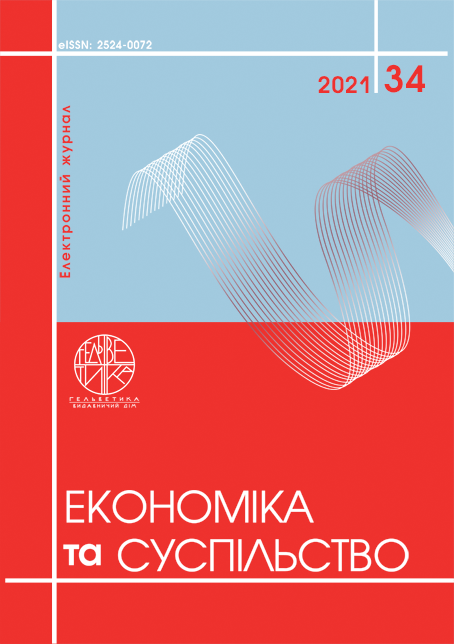ІНСТРУМЕНТИ ФОРМУВАННЯ ТА РОЗВИТКУ СВІТОВИХ ТУРИСТИЧНИХ КЛАСТЕРІВ
Анотація
В дослідженні охарактеризовано методологічні засади оцінки потенціалу туристичних кластерів та об'єктів туристичної діяльності в європейському просторі. Визначено об’єктивну необхідність застосування кластерного підходу в дослідженні світової індустрії туризму. Зазначено, що кластерний підхід як засіб дослідження потрібен для створення просторового розвитку світових туристичних регіонів. Розглянуто індекс конкурентоспроможності за сукупністю показників, що згруповано в субіндекси. Водночас наведено перелік індикаторів, які дозволять виявити проблему розвитку туризму, забезпечити умови для повноцінного функціонування суб’єктів туристичної діяльності, збільшити обсяги залучення інвестицій, створити конкурентоздатний туристичний продукт, який максимально забезпечить потреби внутрішнього і міжнародного туризму. Наведено характеристику регіональних кластерів та здійснено кластерний аналіз інструментів, які створюють потенціал кластерів в європейській індустрії туризму.
Посилання
Benedict M.A., McMahon E.T. Green infrastructure: linking landscapes and communities. Washington: Island Press. 2006. 299 р.
Bergman E.М., Feser E.J. Industrial and Regional Clusters: Concepts and Comparative Applications. Morgantown: Regional Research Institute. 1999. 408 р.
Butler R. The Concept of a Tourist Area Cycle of Evolution: Implications for Management of Resources. Canadian Geographer. 2006. Vol. 24, рр. 5–12.
Ceballos-Lascurain H. Tourism, Ecotourism and Protected Areas: The State of Nature-Based Tourism around the World and Guidelines for Its Development. Cambridge: IUCN Publications. 1996. 301 р.
Trusova N.V., Cherniavska T.A., Pasieka S.R., Hranovska V.Hr., Prystemskyi O.S., Demko V.S. Innovative clustering of the region in the context of increasing competitive positions of the enterprises of the tourist-recreational destination. GeoJournal of Tourism and Geosite. 2020. Vol. 33(3), рр. 1126–1134.
Trusova N.V., Kyrylov Yu.Y., Hranovska V. Hr., Prystеmskyi O.S., Sakun A. Zh. The imperatives of the development of the tourist services market in spatial polarization of the regional tourist system. GeoJournal of Tourism and Geosites. 2020. Vol. 29(2), рр. 565–582.
Gorina G.O., Barabanova V.V., Bohatyryova G.A., Nikolaichuk O.A., Romanukha O.M. Clustering of regional tourism service markets according to indicators of the functioning of subjects of tourism activity. Journal of Geology, Geography and Geoecology. 2020. Vol. 29. № 4, рр. 684–692.
Cunha J. Tourism Cluster Competitiveness and Sustainability: Proposal for a Systemic Model to Measure the Impact of Tourism on Local Development. Brazilian Administration Review. 2005. № 2(2), рр. 47–62.
Frederick S., Simmons M., Gallagher M. The ecological imperative for environmental design and planning. Frontiers in Ecology and the Environment. 2013. Vol. 11(7), рр. 355–361.
Goeldner C.R., Ritchie J.R. Tourism: principles, practices, philosophies. Hoboken: John Wiley & Sons, Inc. 2009. 626 р.
Hall C.M., Page S.J. The Geography of Tourism and Recreation: Environment, Place and Space. New York: Routledge. 2014. 470 р.
Hardin G. The Tragedy of the Commons. Science. 1968. Vol. 162(3859), рр. 1243–1248.
Kuśen E.A. System of tourism attractions. Tourism. 2010. Vol. 58(4), рр. 409–424.
Lindqvist G., Solvell О., Ketels Ch. The Cluster Initiative Greenbook 2.0. Stockholm: Ivory Tower Publishers. 2013. 66 p.
Nordin S. Tourism Clustering & Innovation: path to economic growth and development. Östersund: European Tourism Research Institute. 2003. 90 р.
Selin S. Developing a typology of sustainable tourism partnerships. Journal of Sustainable tourism. 1999. Vol. 7(3), рр. 260–273.
Sevenant M., Antrop M. Cognitive attributes and aesthetic preferences in assessment and differentiation of landscapes. Journal of Environmental Management. 2009. Vol. 90, рр. 2889–2899.
The UNWTO Tourism Dashboard – Insights on key performance indicators for inbound and outbound tourism at the global, regional and national levels. UNWTO Tourism Dashboard. URL: https://www.unwto.org/unwto-tourism-dashboard
Benedict, M.A., McMahon, E.T. (2006). Green infrastructure: linking landscapes and communities. Washington: Island Press. 299 р.
Bergman, E.М., Feser, E.J. (1999). Industrial and Regional Clusters: Concepts and Comparative Applications. Morgantown: Regional Research Institute. 408 р.
Butler, R. (2006). The Concept of a Tourist Area Cycle of Evolution: Implications for Management of Resources. Canadian Geographer, 24, 5–12.
Ceballos-Lascurain, H. (1996). Tourism, Ecotourism and Protected Areas: The State of Nature-Based Tourism around the World and Guidelines for Its Development. Cambridge: IUCN Publications. 301 р.
Trusova, N.V., Cherniavska, T.A., Pasieka, S.R., Hranovska, V.Hr., Prystemskyi, O.S., Demko, V.S. (2020). Innovative clustering of the region in the context of increasing competitive positions of the enterprises of the tourist-recreational destination. GeoJournal of Tourism and Geosite, 33(3), 1126–1134.
Trusova, N.V., Kyrylov, Yu.Y., Hranovska, V. Hr., Prystеmskyi, O.S., Sakun, A. Zh. (2020). The imperatives of the development of the tourist services market in spatial polarization of the regional tourist system. GeoJournal of Tourism and Geosites, 29(2), 565–582.
Gorina, G.O., Barabanova, V.V., Bohatyryova, G.A., Nikolaichuk, O.A., Romanukha, O.M. (2020). Clustering of regional tourism service markets according to indicators of the functioning of subjects of tourism activity. Journal of Geology, Geography and Geoecology. Vol. 29. № 4, рр.684–692.
Cunha, J. (2005). Tourism Cluster Competitiveness and Sustainability: Proposal for a Systemic Model to Measure the Impact of Tourism on Local Development. Brazilian Administration Review, 2(2), 47–62.
Frederick, S., Simmons, M., Gallagher, M. (2013). The ecological imperative for environmental design and planning. Frontiers in Ecology and the Environment, 11(7), 355–361.
Goeldner, C.R., Ritchie, J.R. (2009). Tourism: principles, practices, philosophies. Hoboken: John Wiley & Sons, Inc. 626 р.
Hall, C.M., Page, S J. (2014). The Geography of Tourism and Recreation: Environment, Place and Space. New York: Routledge. 470 р.
Hardin, G. (1968). The Tragedy of the Commons. Science, 162(3859), 1243–1248.
Kuśen, E.A. (2010). System of tourism attractions. Tourism, 58(4), 409–424.
Lindqvist, G., Solvell, О., Ketels, Ch. (2013). The Cluster Initiative Greenbook 2.0. Stockholm: Ivory Tower Publishers. 66 p.
Nordin, S. (2003). Tourism Clustering & Innovation: path to economic growth and development. Östersund: European Tourism Research Institute. 90 р.
Selin, S. (1999). Developing a typology of sustainable tourism partnerships. Journal of Sustainable tourism, 7(3), 260–273.
Sevenant, M., Antrop, M. (2009). Cognitive attributes and aesthetic preferences in assessment and differentiation of landscapes. Journal of Environmental Managemen, 90, 2889–2899.
The UNWTO Tourism Dashboard – Insights on key performance indicators for inbound and outbound tourism at the global, regional and national levels. UNWTO Tourism Dashboard. Retrieved from: https://www.unwto.org/unwto-tourism-dashboard


